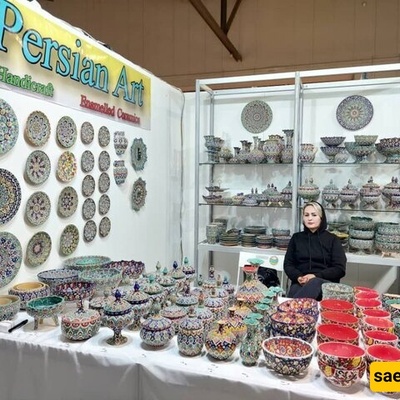This time, we want to get acquainted with the art of jewelry embroidery — an art that is used in many instances. Stay with Saed News as we introduce this beautiful art.

Jewelry Embroidery
Jewelry embroidery is one of the oldest arts of Iran, used to add more beauty to fabric clothes, felt, leather, and other materials. Jewelry embroidery is different from jewelry making. This beautiful art has been welcomed by humans since ancient times, who decorated their clothes with precious stones and gems to showcase their splendor and grandeur. Those with more wealth used more precious stones and decorations, while people with moderate or lower financial status used cheaper stones, gems, and metals to adorn themselves and their clothing.

What is Jewelry Embroidery?
Jewelry embroidery is essentially the art of decorating clothes and garments using precious, semi-precious, or inexpensive materials. It involves arranging and attaching various stones, gems, beads, sequins, filigree, etc., onto fabric. Generally, jewelry embroidery incorporates other crafts such as beadwork, pearl embroidery, goldwork (sermeh-doozi), sequin embroidery, and even traditional embroidery. The combination of these beautiful handicrafts forms jewelry embroidery. Getting familiar with the tools used in jewelry embroidery helps to understand it better.
History of Jewelry Embroidery
Iran, due to the diversity of its ethnic groups—each with its own clothing, traditions, and customs—is very rich in material and spiritual achievements. Jewelry has long been considered part of clothing among various ethnic groups in Iran. The Qashqai tribes and Arabs of the Khuzestan region have been the greatest users of jewelry. Among the Qashqai people, jewelry includes items such as the Mahlou necklace, clove necklace, beaded necklace, ‘Anbardaan’ (amulet cases), Quran cases, bangles, beaded bracelets, headbands, and armbands.
Required Tools for Jewelry Embroidery
Jewelry embroidery incorporates several arts such as beadwork, pearl embroidery, goldwork (sermeh-doozi), sequin embroidery, and even embroidery. The combination of these crafts creates the art of jewelry embroidery. Getting to know the tools will deepen your understanding.






Frame (Kar-gah): One of the most important tools in jewelry embroidery, it keeps the fabric or felt firm while you work. Frames come in various materials and sizes, such as wooden, plastic, clamp-type, and gel frames.
Base Material: The base for jewelry embroidery can be leather or suede, felt, or organza fabric. Materials like sequins, pearls, and stones are sewn onto the base with thread and needle.
Nylon Thread: One of the most important threads used in jewelry embroidery is nylon thread. It is available in many colors in the market, allowing you to choose a color matching the base fabric so the thread is less visible. Many artists also creatively use colorful nylon threads to make attractive products.
Suitable Needles: Needles numbered 11 to 13 are ideal for jewelry embroidery and beadwork, as they easily pass through different materials. Dull needles can make the work tiresome or cause damage, so it’s important to choose sharp needles.
Beads (Manjooq): A widely used material due to their small size, beads are used to fill surfaces or edge decorations.
Sequins (Poulak): These materials are flat or concave and come in various sizes and colors. Shapes include flat, bowl-shaped, coin-shaped, and shell-like. The most commonly used type is flat sequins size 4.
Filigree (Meliileh) and Broken Filigree: Filigree resembles elongated cylindrical beads and comes in various colors. Broken filigree is half the length of a whole filigree.
Gems (Negin): Stones with two holes on opposite sides, sewn onto fabric using thread through these holes. Gems can be with or without a base.
Goldwork (Sermeh): One of the most used goldwork types is found in brooches and luxurious insect-shaped ornaments. Its structure is firmer and more resistant than other types. It looks similar to flat goldwork at first glance but has a springy, strong structure.
Goldwork Thread: Special thread used for goldwork.
Ball Chain: Many of us are familiar with ball chains used in keychains. These consist of small metal balls linked to form a long chain.
Jewelry Glue: Glues are also essential in jewelry embroidery. The best types are glues for gems and stones, which dry clear without leaving marks. The most popular and accessible glue is B7000, available in large, medium, and small tubes. Other glues include E6000, F6000, and T8000.
Synthetic Leather and Suede: After completing the jewelry embroidery, synthetic leather or suede can be used to cover the back and attach brooch pins. Sometimes felt is also used as backing. Synthetic leather is smooth and shiny, while suede has a fuzzy surface.
Scissors: Small, sharp scissors are used to cut felt and leather, and thread cutters are used to trim threads and delicate parts.
Thread Cutter (Nakh Chin): A tool to cut threads precisely.
Brooch Pins (Sanqah Pixel): Used for items like brooches or pins to attach them to clothing, available in various sizes.

Applications of Jewelry Embroidery
This art is a combination of beadwork, stonework, and embroidery. Jewelry embroidery on clothing is a type of decoration where various stones, pearls, beads, and sequins are sewn onto fabric following a pre-designed pattern. Traditionally, jewelry embroidery was used to adorn fabrics and clothing, but today it is also used in making various jewelry pieces, decorating bags, shoes, and furniture.
Jewelry embroidery is done in two ways: stones and beads are either sewn directly onto the main fabric, or first embroidered onto a piece of felt, tulle, or fabric, cut out, and then sewn onto the final product as appliqué or patches.
Jewelry embroidery comes in different types, all with similar working methods. By knowing and acquiring these tools, one can create various jewelry items and enjoy using and seeing them.

